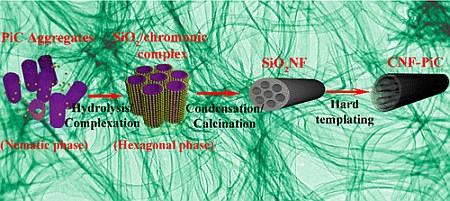From Chromonic Self-Assembly to Hollow Carbon Nanofibers: Efficient Materials in Supercapacitor and Vapor-Sensing Applications
Conxita Solans, Scientific Director of the Unit 12 NANBIOSIS is co-author of the research article recently published a research article in the journal Applied Materials & Interfaces.
Carbon nanofibers (CNFs) with high surface area (820 m2/g) have been successfully prepared by a nanocasting approach using silica nanofibers obtained from chromonic liquid crystals as a template. CNFs with randomly oriented graphitic layers show outstanding electrochemical supercapacitance performance, exhibiting a specific capacitance of 327 F/g at a scan rate of 5 mV/s with a long life-cycling capability. Approximately 95% capacitance retention is observed after 1000 charge–discharge cycles. Furthermore, about 80% of capacitance is retained at higher scan rates (up to 500 mV/s) and current densities (from 1 to 10 A/g). The high capacitance of CNFs comes from their porous structure, high pore volume, and electrolyte-accessible high surface area. CNFs with ordered graphitic layers were also obtained upon heat treatment at high temperatures (>1500 °C). Although it is expected that these graphitic CNFs have increased electrical conductivity, in the present case, they exhibited lower capacitance values due to a loss in surface area during thermal treatment. High-surface-area CNFs can be used in sensing applications; in particular, they showed selective differential adsorption of volatile organic compounds such as pyridine and toluene. This behavior is attributed to the free diffusion of these volatile aromatic molecules into the pores of CNFs accompanied by interactions with sp2 carbon structures and other chemical groups on the surface of the fibers.
Article of reference: ACS Appl. Mater. Interfaces, 8 (45), 31231–31238, 2016









